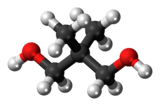Neopentyl glycol
 | |
 | |
| Names | |
|---|---|
| Preferred IUPAC name
2,2-Dimethylpropane-1,3-diol | |
| Other names
2,2-Dimethyl-1,3-propanediol | |
| Identifiers | |
| 126-30-7 | |
| 3D model (Jmol) | Interactive image |
| ChemSpider | 13835293 |
| ECHA InfoCard | 100.004.347 |
| PubChem | 31344 |
| |
| |
| Properties | |
| C5H12O2 | |
| Molar mass | 104.148 g/mol |
| Melting point | 129.13 °C (264.43 °F; 402.28 K) |
| Boiling point | 208 °C (406 °F; 481 K) |
| soluble in water | |
| Solubility | soluble in benzene, chloroform, very soluble in ethanol, diethyl ether |
| Thermochemistry | |
| Std enthalpy of formation (ΔfH |
-551.2 kJ•mol−1 |
| Hazards | |
| Flash point | 129 °C (264 °F; 402 K) |
| Except where otherwise noted, data are given for materials in their standard state (at 25 °C [77 °F], 100 kPa). | |
| | |
| Infobox references | |
Neopentyl glycol (IUPAC name: 2,2-dimethylpropane-1,3-diol) is an organic chemical compound. It is used in the synthesis of polyesters, paints, lubricants, and plasticizers. When used in the manufacture of polyesters, it enhances the stability of the product towards heat, light, and water. By esterification reaction with fatty or carboxylic acids, synthetic lubricating esters with reduced potential for oxidation or hydrolysis, compared to natural esters, can be produced.
Reactions
Neopentyl glycol is synthesized industrially by the aldol reaction of formaldehyde and isobutyraldehyde. This creates the intermediate hydroxypivaldehyde, which can be converted to neopentyl glycol with either excess formaldehyde or catalytic hydrogenation of the aldehyde group to an alcohol group.[2]
It is used as a protecting group for ketones, eg gestodene synthesis.
References
- ↑ Lide, David R. (1998), Handbook of Chemistry and Physics (87 ed.), Boca Raton, FL: CRC Press, pp. 3‑228, 5‑42, 16‑22, ISBN 0-8493-0594-2
- ↑ Weissermel, Klaus; Arpe, Hans-Jürgen; Lindley, Charlet R. (2003), Industrial Organic Chemistry (4 ed.), Wiley-VCH, pp. 214–215, ISBN 978-3-527-30578-0, retrieved 2009-07-20